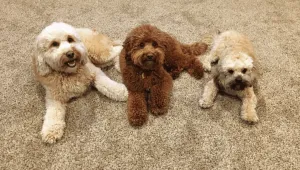Finding a qualified dog trainer or behaviorist can be a total mine field. When looking for a trainer or behaviourist for your dog it is important to find one that is qualified, experienced, and has an excellent reputation.
So if you’re wondering how to find a good dog trainer or behaviorist, read on!
Table of Contents
ToggleContents of this article:
- How to find a good dog trainer.
- What is the difference between a dog trainer and a behaviorist?
- Do you need qualifications to be a dog trainer or behaviorist?
- How to find a qualified dog trainer or behaviorist.
- How to choose a dog trainer.
- Questions to ask a dog trainer.
- What qualifications should you look for in a dog trainer?
- Membership of a professional dog training organization.
- Kindness in dog training is not just for canines!
- Different formats of dog training.
- Who should I hire if my dog has a behaviour problem?
- Why has my dog trainer or behaviorist asked me to see the vet first?
- What if I choose a bad dog trainer?
- Final words.
How to find a good dog trainer.
There are many different types of trainers and behaviourists, so how do you know which is the best fit for your dog? This guide will help you find the right trainer or behaviourist for your furry friend.
What is the difference between a dog trainer and a behaviorist?
Dog trainers and behaviorists have varying degrees of knowledge and experience, which may include formal and informal training.
A dog trainer helps owners teach their dogs basic obedience commands such as sit, stay, come, and down.
A behaviorist is a professional who understands the emotional drivers of dog behavior and helps owners manage, modify, and resolve their dogs’ problematic behaviors.
What do dog trainers do?
As anyone who has ever owned a dog can attest, having a well-trained canine companion can make a world of difference. That’s why dog trainers play such an important role in the lives of both dogs and their owners.
Dog trainers work with a wide range of clients, from puppy owners who want to get a head start on obedience training to competitive handlers who are preparing for shows.
While the specific duties of a dog trainer vary depending on the individual and the type of training being provided, all trainers help owners to teach their dogs new behaviors.
Trainers often offer services that include working with groups of dog owners in classes and also individual consultations on a one-to-one basis.
What do dog behaviorists do?
Have you ever wondered what goes on inside your dog’s head? If you’re like most dog owners, you’ve probably had moments where you’ve been baffled by your furry friend’s behavior. That’s where dog behaviorists come in.
Dog behaviorists are experts in understanding how dogs think, feel and communicate. They use this knowledge to help dog owners train their pets and resolve behavioral problems.
Dog behaviorists typically work with dogs of all ages and breeds. However, they may specialize in working with dogs with specific behavioral issues.
Behaviorists offer private consultations, during which they observe the dog and its owner to identify the root of the problem. They then work with the owner to teach them how to modify the dog’s behavior.
In some cases, medication may be prescribed to help manage the dog’s symptoms.
Differences between dog trainers and behaviorists.
When it comes to training dogs, there are two main groups of professionals: dog trainers and dog behaviorists. Although both groups share the goal of helping dogs learn good behavior, there are some key differences between the two.
Dog trainers typically focus on teaching obedience commands, such as sit, stay, and come.
In contrast, dog behaviorists take a more holistic approach to training, looking at the dog’s overall behavior and working to modify any unwanted behaviors.
In addition, dog behaviorists often have a background in animal behavior or psychology, which gives them a deeper understanding of how dogs think and learn. As a result, they are better equipped to identify and solve problem behaviors.
Whoever you choose to help you with your dog, the most important thing is finding someone qualified, who you feel comfortable working with and who has experience helping dogs with similar issues.
Do you need qualifications to be a dog trainer or behaviorist?
Dog training and behavior is an unregulated industry. In the United States, there are no government-sponsored agencies that oversee the training and behavior of dogs.
This lack of regulation means that anyone can claim to be a dog trainer or behaviorist, regardless of their qualifications or experience.
As a result, it can be difficult for pet owners to know who to trust when it comes to training their dog. There are a few things that you can do to help ensure that you find a qualified trainer or behaviorist.
How to find a qualified dog trainer or behaviorist.
First, ask for recommendations from friends, family, or your veterinarian.
Second, look for someone who has been certified by a professional organization, such as the Association of Professional Dog Trainers or the International Association of Animal Behaviorists.
Finally, be sure to interview potential trainers or behaviorists before making a commitment.
By taking these steps, you can help to ensure that you find someone who will help your dog reach his or her full potential.
How to choose a dog trainer.
When looking for a qualified dog trainer, look for someone who is committed to force-free, reward-based training. This type of training relies on positive reinforcement to help dogs learn desired behaviors, and it is proven to be more effective and less harmful than punitive methods.
Questions to ask a dog trainer.
To help you determine who is genuine, I have taken some questions from world-renowned dog trainer Jean Donaldson. These questions can help you identify people who are truly dedicated to your pet’s safety and well-being.
Ask these three things:
What will happen to my dog if they get the behavior right?
What will happen to my dog if they get the behavior wrong?
Are there any less invasive alternatives to what you propose?
Jean Donaldson.
What should the answers be?
What will happen to my dog if they get the behavior right?
The trainer should say that the dog will be rewarded with a treat, toy, or whatever makes your dog happy. I once worked with a rescue greyhound who found leaning against his owners the most rewarding thing in the world!
What will happen to my dog if they get the behavior wrong?
If a dog gets a behavior wrong, there are two reasons for this. Either they don’t understand what they’re being asked in that context, or they’re not motivated enough to perform the behavior.
If this is the case, we should make it easier for the dog to understand what we’re asking of them and make it worth their while to perform the behavior.
This may involve changing something about the environment to make it easier for the dog to focus, or it may mean going back a few steps to luring the behavior again so your dog can get more practice.
The trainer should NEVER say that the dog will be punished if they get the behavior wrong. This includes things like yanking the leash, scolding, hitting, shaking rattle cans, spraying water bottles or using electric shock collars.
Be mindful of language used to make punitive methods sound more palatable – a leash pop sounds kind of fun until you understand what it involves.
Are there any less invasive alternatives to what you propose?
The answer we’re looking for here is “There are presently no less invasive alternatives than these methods”. If they start talking about how some dogs need a firm hand and that positive reinforcement doesn’t work with all dogs, walk away!
If zoos can use positive reinforcement techniques to train a tiger to accept a blood draw, then there’s really no excuse for using anything else on a pet dog.
What qualifications should you look for in a dog trainer?
In order to be qualified, dog trainers should hold formal credentials. Simply watching a lot of TV programs and having dogs their entire life does not make someone competent enough to entrust your dog’s education to.
We demand that our human children’s teachers are properly educated and certified, so it is important that our dogs receive the same level of care.
The following are the best credentials to search for: CTC, KPA CTP, VSA-CDT, VSPDT, and PMCT (those are the letters that will appear after your dog trainer’s name).
Many good dog trainers have an undergraduate or graduate degree in animal behavior.
Membership of a professional dog training organization.
When you’re looking for a dog trainer, membership in a professional organization is another item to look for. These organizations ensure that your trainer is held accountable to a set of ethical standards and a code of conduct.
As a result, you can be confident that your trainer will always act in the best interests of your dog. In addition, membership in a professional organization can give you access to resources and support that you may not otherwise have.
If you’re ever unhappy with your trainer’s services, you can always file a complaint with the organization. And if your trainer ever faces disciplinary action, you’ll be able to find out about it through the organization.
So when you’re choosing a trainer, be sure to ask if they’re a member of any professional organizations.
One such organization is the Pet Professional Guild (PPG), which is committed to force-free training methods. PPG members believe that all dogs have the right to be trained using gentle, reward-based techniques.
In addition to promoting humane training methods, the PPG also provides its members with access to a network of like-minded professionals, educational resources, and industry news.
If a dog trainer tells you they’re a member of a certain organization, you can look them up on the organization’s website to verify their membership.
Look up the code of ethics for any membership organizations your trainer belongs to – some of them have higher standards than others!
Kindness in dog training is not just for canines!
As any dog trainer will tell you, one of the most important things to remember is to be kind to your dog. After all, dogs are not born knowing how to behave, and it is up to us to teach them. That said, it is also important to remember that kindness is not just for dogs but for people too.
Force-free dog training is based on the principle of positive reinforcement, which means that rewards are given for good behaviour, rather than punishment for bad behaviour. This rewards-based approach is not only more effective, but it is also much more humane.
As trainers, we need to set the example by being kind and courteous to our human clients, and to each other – as well as to our dogs!
Different formats of dog training.
There are a few different formats that dog trainers use to deliver their services.
Some dog trainers work with groups of dogs in a classroom setting, while others provide private lessons for individual dogs and their owners.
There are also trainers who offer board and train services, where the dog stays with the trainer and receives intensive training for a period of time. And there are even trainers who offer online training courses.
When you’re choosing a trainer, it’s important to consider what format would best suit your needs.
Private vs group dog training.
There are a lot of factors to consider when choosing between classes and private dog training lessons. Private lessons may be more expensive, but they offer a few advantages.
First, you’ll have the trainer’s undivided attention. This means they can tailor the lessons to your dog’s specific needs.
Second, private lessons can be scheduled at a time that’s convenient for you. This is important because consistency is key when training a dog.
Finally, private lessons may be a better option if your dog is shy or nervous around other dogs.
If you choose to go the class route, look for a reputable instructor and make sure the class size is small enough that your dog will get plenty of individual attention.
Whichever option you choose, be prepared to put in the time and effort required to see results.
What to look for in a good dog training class.
Training your dog can be a daunting task, but the benefits are clear. A well-trained dog is a pleasure to be around and an asset to any family. But with so many different dog training classes available, how can you choose the right one?
Ask to observe part of a class without your dog present before you commit to one. Any trainer with nothing to hide should agreed to this.
Here are a few things to look for in a good dog training class:
- Instructors should be experienced and certified. They should have a thorough knowledge of canine behavior and effective training techniques.
- The class size should be small enough to allow for individual attention. This is especially important for puppies or dogs with behavioral issues.
- The training methods should be humane and effective. Aversive techniques such as shock collars or physical punishment should never be used as there can be serious fallout that can affect your dog’s behavior in unpredictable ways.
- The class should be fun for both you and your dog. It should be an opportunity for you to bond with your furry friend and learn together.
With these things in mind, you’re sure to find the perfect dog training class for you and your pup.
Is online dog training effective?
As any dog owner knows, training a pup can be rewarding but also challenging. Fortunately, there are now a number of online dog training courses available that can help owners teach their furry friends basic obedience and manners.
These courses typically include a series of video lessons that cover everything from potty training to proper leash walking. In addition, most courses offer access to a private online community where owners can ask questions and get advice from experienced trainers.
Online dog training courses can be a great way for busy dog owners to get the guidance they need to train their pups effectively, but it’s still important to make sure they are created and run by qualified, force-free trainers.
Is board and train worth it?
When you leave your dog at a boarding kennel, you want to be sure that he or she will be well taken care of. But what if your dog could also come home trained?
Board and train programs are becoming increasingly popular with pet owners who want the best for their furry friends. These programs typically last two to four weeks, during which time your dog will stay at the trainer’s facility and receive daily training sessions.
Many board and train programs focus on obedience training, but some also offer specialized training, such as behavior modification or socialization.
It is even more important with a board and train to understand which methods will be used on your dog and how they will be trained because you will not be present to advocate for your pet.
When choosing a board and train program, be sure to ask about the trainers’ experience and qualifications, as well as the facility’s policies and procedures.
With a little research, you can find a program that’s right for you and your dog.
Who should I hire if my dog has a behaviour problem?
Reward-based approaches are still used even if your dog has a behavioural issue. For more information, see the American Veterinary Society for Animal Behavior’s position statement on humane dog training.
“Reward-based techniques should be used for teaching common training skills as well as to address unwanted behaviors. The application of aversive methods – which, by definition, rely on application of force, pain, or emotional or physical discomfort – should not be used in canine training or for the treatment of behavioral disorders.”
American Veterinary Society for Animal Behavior
Why has my dog trainer or behaviorist asked me to see the vet first?
Before starting any training or behavioral modification program with your dog, your canine professional should ask you to visit the veterinarian first. This may seem like an unnecessary step, but there are actually good reasons for it.
The vet can rule out any health problems that could affect your dog’s behavior. For example, if your dog is acting aggressively, it could be due to pain from an injury or illness.
It would amaze you how many behavioral problems are because of undiagnosed pain – whether that’s musculoskeletal issues such as hip dysplasia, or gut problems caused by undiagnosed food allergies, intolerances and sensitivities.
Dogs disguise pain very well so by taking the time to see the vet first, you can ensure that you and your dog trainer have all the information needed to help you successfully train your furry friend.
What if I choose a bad dog trainer?
If you’re looking for a dog trainer, it’s important to do your research to find someone who uses the training methods that you’re comfortable with.
Unfortunately, some people have the experience of signing up with a trainer who they thought used positive reinforcement techniques, only to find out that the trainer actually recommends aversive techniques or tools.
This can be an alarming and upsetting experience. If you find yourself in this situation, remember that you are your dog’s advocate.
If your trainer treats your dog in a way you are not comfortable with, don’t allow that to go unchallenged. It may be tricky to speak up, but it’s important to do what’s best for your dog.
With time and patience, you’ll be able to find a trainer who uses the methods that you’re comfortable with.
Final words.
Congratulations on being a dedicated dog owner! I hope the information provided in this article will be useful in helping you find a good dog trainer.
There are a few key things to remember when looking for a trainer, such as making sure they use food as a training tool, that they have an educational background in dog training, and that they are a member of a professional body.
Additionally, it is important to choose a trainer who takes part in continuing education, as this shows they are keeping up with the latest advancements in the field.
If you see any of the warning signs mentioned in the article, it is best to keep looking, as your dog deserves only the best. With dedication and perseverance, you are sure to find the perfect trainer for your furry friend.
For more dog training tips, head over to our training section.







